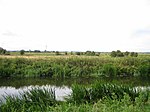Long Sutton, Somerset

Long Sutton is a village and civil parish in Somerset, England, situated 4 miles (6.4 km) south of Somerton in the South Somerset district. The village has a population of 833.The village of Long Sutton has a village green with a lime tree at each corner and a chestnut tree in the centre. The Devonshire Arms Hotel is at one end of the green and at the other are the school and Holy Trinity church, dating from 1493. The village is made up of two hamlets, Knole at one end and Upton at the other. The Reading to Taunton line railway runs under the bridge at Upton and at one time certain trains stopped at Long Sutton and Pitney Halt, as it was called until its closure in the early 1960s. The bridge over the River Yeo is medieval in origin, but was probably reshaped in the 18th century.
Excerpt from the Wikipedia article Long Sutton, Somerset (License: CC BY-SA 3.0, Authors, Images).Long Sutton, Somerset
Back Street,
Geographical coordinates (GPS) Address Nearby Places Show on map
Geographical coordinates (GPS)
| Latitude | Longitude |
|---|---|
| N 51.025841 ° | E -2.760555 ° |
Address
Back Street
Back Street
TA10 9JP
England, United Kingdom
Open on Google Maps









